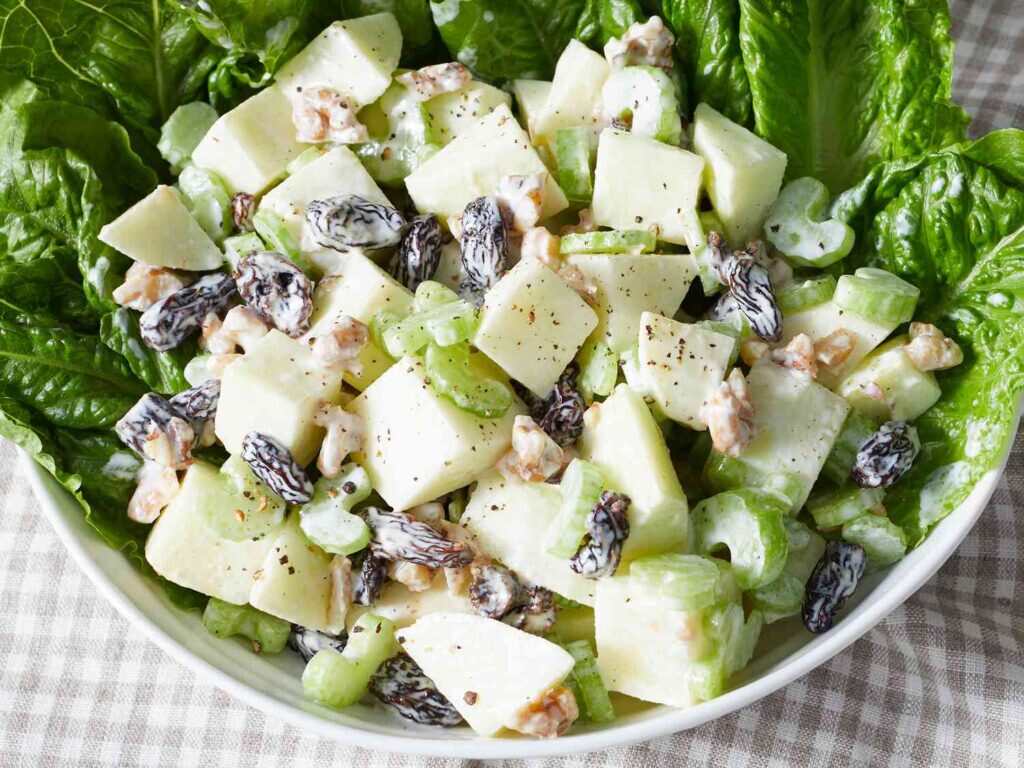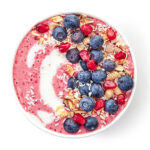Waldorf salad is a timeless classic in the world of salads, known for its simple yet harmonious blend of crisp apples, crunchy celery, sweet grapes, and toasted walnuts. Originally created at the Waldorf-Astoria Hotel in New York City in the late 19th century, this refreshing dish has stood the test of time and is cherished for its delightful combination of flavors and textures.
| Ingredients: | |
| 1 | 2 medium apples (such as Granny Smith or Gala), cored and diced |
| 2 | 1 cup celery, thinly sliced |
| 3 | 1 cup red seedless grapes, halved |
| 4 | 1/2 cup walnuts, toasted and chopped |
| 5 | 1/2 cup mayonnaise |
| 6 | 2 tablespoons lemon juice |
| 7 | Salt and pepper to taste |
| 8 | Fresh lettuce leaves (optional, for serving) |
Step-by-step cooking instruction of Waldorf ssalad:
Step-1 In a large mixing bowl, combine the diced apples, sliced celery, halved grapes, and chopped walnuts.
Step-2 In a separate small bowl, whisk together the mayonnaise and lemon juice until well combined. This will be the dressing for the salad.
Step-3 Pour the dressing over the apple mixture and gently toss until all the ingredients are evenly coated.
Step-4 Season the salad with a pinch of salt and a dash of pepper, adjusting to taste.
Step-5 If desired, line a serving plate with fresh lettuce leaves. This adds an extra layer of texture and presentation to the salad.
Step-6 Spoon the Waldorf salad onto the lettuce-lined plate or into individual serving dishes.
Step-7 Serve the salad immediately as a refreshing appetizer, side dish, or light lunch option.
Nutritional values of Waldorf salad:
The nutritional values of a Waldorf salad can vary based on serving size, specific ingredients used, and any modifications to the traditional recipe. However, here’s a general breakdown of the approximate nutritional values for a standard serving of Waldorf Salad (about 1 cup or 150 grams) using the basic recipe provided earlier:
Please note that these values are approximate and can vary depending on factors such as portion size, specific ingredients, and variations in preparation.
| 1 | Calories: around 250-300 kcal |
| 2 | Carbohydrates: around 25-30 grams |
| 3 | Protein: around 3-5 grams |
| 4 | Fat: around 16-20 grams |
| 5 | Dietary Fiber: around 4-5 grams |
| 6 | Sugars: around 18-20 grams |
| 7 | Sodium: around 150-250 mg |
Background History of Waldorf salad:
The Waldorf salad has an interesting and historic background that dates back to the late 19th century. Its creation is attributed to Oscar Tschirky, the maître d’hôtel (headwaiter) of the prestigious Waldorf-Astoria Hotel in New York City.
In the 1890s, the Waldorf-Astoria Hotel was a hub of luxury and sophistication, attracting elite guests from around the world. Oscar Tschirky, known as “Oscar of the Waldorf,” was renowned for his culinary innovations and impeccable service. He is credited with introducing the concept of the “maître d’hôtel” and creating a variety of new dishes that became popular among the hotel’s high-society clientele.
The story goes that Tschirky invented the Waldorf Salad around 1893 for a special event or occasion at the hotel. The original recipe included only three ingredients: apples, celery, and mayonnaise. Over time, this simple combination gained popularity and became a signature dish of the Waldorf-Astoria.
The salad’s popularity was further boosted when it was featured in Tschirky’s cookbook, “The Cook Book by ‘Oscar’ of the Waldorf,” which was published in 1896. This cookbook showcased the Waldorf Salad recipe, helping to spread its fame beyond the confines of the hotel.
As the years went by, variations of the Waldorf Salad recipe emerged. One of the most notable additions was grapes, which provided a burst of sweetness and complemented the other ingredients. The addition of toasted walnuts also became a common enhancement, adding a nutty crunch to the salad.
Today, the Waldorf salad remains a classic and beloved dish, enjoyed in homes, restaurants, and gatherings worldwide. Its enduring popularity speaks to its timeless appeal and the ingenuity of its creator, Oscar Tschirky, whose culinary legacy continues to live on through this iconic salad.
| Advantages of Waldorf Salad | |
| 1 | Nutrient-Rich Ingredients: Waldorf Salad is made with nutrient-dense ingredients like apples, celery, grapes, and walnuts. These provide essential vitamins, minerals, dietary fiber, and healthy fats. |
| 2 | Balanced Flavors: The combination of sweet apples, tart grapes, crunchy celery, and toasted walnuts creates a well-balanced flavor profile that appeals to various taste preferences. |
| 3 | Texture Variety: The mixture of crisp and tender ingredients offers a pleasing contrast of textures, adding to the overall eating experience. |
| 4 | Customizable: Waldorf Salad is highly adaptable. You can adjust the recipe to include different types of apples, nuts, dressings, or additional ingredients like raisins or dried cranberries. |
| 5 | Light and Refreshing: As a fruit and vegetable-based salad, Waldorf Salad is often light and refreshing, making it a great option for a side dish or a light meal on a warm day. |
| 6 | Quick and Easy: The basic preparation of Waldorf Salad involves chopping and mixing ingredients, making it relatively quick and easy to put together. |
| 7 | Serving Flexibility: Waldorf Salad can be served as an appetizer, side dish, or even as a light lunch. It’s suitable for various occasions and meal settings. |
| Disadvantages of Waldorf Salad | |
| 1 | Calorie and Fat Content: The mayonnaise-based dressing and nuts in Waldorf Salad contribute to its calorie and fat content. Overindulging can lead to consuming more calories than intended. |
| 2 | Added Sugars: Some variations of Waldorf Salad may contain added sugars, particularly if sweetened yogurt or dressings are used. This might affect the nutritional value overall. |
| 3 | Allergies and Dietary Restrictions: Waldorf Salad contains common allergens such as nuts (walnuts) and dairy (mayonnaise). It may not be suitable for individuals with nut allergies or those following a vegan or dairy-free diet. |
| 4 | High Sodium Dressings: Commercial dressings, especially store-bought mayonnaise, can be high in sodium. This can contribute to daily sodium intake, which should be monitored for individuals with certain health conditions. |
| 5 | Nut Allergies: While nuts are a traditional component of Waldorf Salad, they can pose a risk to individuals with nut allergies. Substituting or omitting the nuts may affect the salad’s texture and flavor. |
| 6 | Potential Imbalance: If not prepared with care, the salad’s ingredients might be disproportionate, leading to an uneven distribution of flavors and textures. |
| 7 | Not a Complete Meal: While nutritious, Waldorf Salad may lack some essential nutrients for a well-rounded meal, such as a sufficient protein source or complex carbohydrates. |
Compare with similar meal of Waldorf salad:
If you enjoy the flavors and textures of Waldorf Salad, you might also like these similar dishes that offer a mix of sweet and savory, crunchy and creamy elements:
| 1 | Fruit and Nut Salad: A variation of the Waldorf Salad, this dish combines a variety of fresh fruits (such as apples, grapes, oranges, and berries) with nuts (like walnuts, almonds, or pecans), and may be served with a yogurt or honey-based dressing. |
| 2 | Chicken Salad: A classic chicken salad typically includes cooked and diced chicken mixed with ingredients like celery, grapes, nuts, and a creamy dressing. It offers a similar balance of textures and flavors as Waldorf Salad, with the addition of protein. |
| 3 | Couscous Salad: A light and versatile option, couscous salad features cooked couscous combined with diced fruits (like apples, dried apricots, or pomegranate seeds), vegetables, herbs, and a tangy vinaigrette. |
| 4 | Quinoa Salad: Quinoa salad is made with cooked quinoa mixed with a variety of colorful vegetables, fruits (such as chopped apples or dried cranberries), nuts, and a flavorful dressing. |
| 5 | Spinach and Strawberry Salad: This salad combines fresh spinach leaves with sliced strawberries, toasted nuts, crumbled cheese (such as feta), and a balsamic vinaigrette. The sweet and savory elements provide a satisfying contrast. |
| 6 | Pear and Blue Cheese Salad: A blend of mixed greens, sliced pears, crumbled blue cheese, candied nuts, and vinaigrette creates a delightful harmony of flavors and textures. |
| 7 | Mango Avocado Salad: A tropical-inspired option, this salad features ripe mango chunks, sliced avocado, red onion, and a zesty lime dressing. Adding nuts or seeds can enhance the crunchiness. |
| 8 | Tuna Salad: Tuna salad combines canned tuna with crunchy vegetables (such as celery and bell peppers), hard-boiled eggs, and a creamy dressing. It can be served over greens or as a sandwich filling. |
| 9 | Roasted Vegetable Salad: Roasted vegetables like sweet potatoes, beets, and carrots, combined with fresh greens, nuts, and vinaigrette, offer a warm and hearty salad option. |
| 10 | Fruit Salsa: A mix of diced fruits (like apples, oranges, and pineapple) combined with herbs, red onion, and lime juice creates a refreshing and tangy salsa that can be served as a side or with grilled meats. |
Mostly questions asked about Waldorf Salad
1: What is Waldorf salad?
A: Waldorf salad is a classic dish made with a blend of diced apples, celery, grapes, and toasted walnuts, mixed with a creamy dressing. It offers a harmonious balance of sweet and savory flavors, as well as a mix of crunchy and tender textures.
2: Who invented Waldorf salad?
A: Waldorf salad is attributed to Oscar Tschirky, the maître d’hôtel of the Waldorf-Astoria Hotel in New York City. He is believed to have created the salad in the 1890s, and it later became a signature dish of the hotel.
3: What are the key ingredients of Waldorf salad?
A: The main ingredients of Waldorf salad include apples, celery, grapes, and walnuts. The salad is typically dressed with mayonnaise or a creamy dressing and seasoned with salt and pepper.
4: Can I customize the ingredients in Waldorf salad?
A: Yes, you can customize Waldorf Salad by adding ingredients like raisins, dried cranberries, different types of nuts, or using alternative dressings such as yogurt or a vinaigrette.
5: Is Waldorf salad healthy?
A: Waldorf salad contains nutritious ingredients like fruits, vegetables, and nuts, providing vitamins, minerals, fiber, and healthy fats. However, the overall healthiness depends on factors like portion size, dressing choice, and additional ingredients.
6: Can I prepare the Waldorf salad in advance?
A: Yes, you can prepare the ingredients for Waldorf salad ahead of time and assemble it just before serving to maintain freshness and crunchiness.
7: What apples are best for Waldorf salad?
A: Crisp and slightly tart apples like Granny Smith or Gala are often recommended for Waldorf Salad due to their texture and flavor that complements the other ingredients.
8: Is Waldorf salad served warm or cold?
A: Waldorf salad is typically served cold, making it a refreshing and chilled dish. The cold temperature enhances the contrast between the crunchy and creamy elements.
9: What can I serve with Waldorf salad?
A: Waldorf salad can be served as a side dish with various main courses such as grilled chicken, turkey, or even sandwiches. It’s also a great addition to buffet spreads and potlucks.
10: Can I make a healthier version of Waldorf salad?
A: Yes, you can make a healthier version of Waldorf Salad by using light or reduced-fat dressings, opting for Greek yogurt instead of mayonnaise, reducing added sugars, and choosing whole grain or nut alternatives for added crunch.







